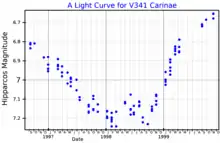 The nebula surrounding HD 65750 | |
| Observation data Epoch J2000 Equinox J2000 | |
|---|---|
| Constellation | Carina |
| Right ascension | 07h 56m 50.94795s[1] |
| Declination | −59° 07′ 32.7605″[1] |
| Apparent magnitude (V) | 6.2 - 7.1[2] |
| Characteristics | |
| Spectral type | M1 II[3] |
| U−B color index | +2.18[4] |
| B−V color index | +1.93[4] |
| Variable type | LB[5] |
| Astrometry | |
| Radial velocity (Rv) | 23.17 km/s |
| Proper motion (μ) | RA: -4.030[6] mas/yr Dec.: 9.789[6] mas/yr |
| Parallax (π) | 2.6230 ± 0.0931 mas[6] |
| Distance | 1,240 ± 40 ly (380 ± 10 pc) |
| Details | |
| Mass | 1.11[7] M☉ |
| Radius | 103[6] R☉ |
| Luminosity | 1,698[6] L☉ |
| Surface gravity (log g) | 0.31[7] cgs |
| Temperature | 3,650[6] K |
| Metallicity [Fe/H] | -0.4[8] dex |
| Other designations | |
| Database references | |
| SIMBAD | data |
HD 65750, also known as V341 Carinae is a bright red giant star in the constellation Carina. It is surrounded by a prominent reflection nebula,[10][9] known as IC 2220, nicknamed the Toby Jug Nebula.
Characteristics

HD 65750 is located about 900 light years away, and has an apparent magnitude that varies between 6.2 and 7.1 and a metallicity just 40% of the Sun. It is part of the Diamond Cluster moving group.
The star has a radial velocity of 20 km/s.[12]
Nebulae
The nebulae is a mystery as the variations in nebulae brightness appear to be unrelated to the host star.[13] One theory is that rather than being an accreting protoplanetary disk the star may be an evolved star that is losing material.[14][15]
References
- 1 2 van Leeuwen, F. (2007). "Validation of the new Hipparcos reduction". Astronomy and Astrophysics. 474 (2): 653–664. arXiv:0708.1752. Bibcode:2007A&A...474..653V. doi:10.1051/0004-6361:20078357. S2CID 18759600. Vizier catalog entry
- ↑ "V341 Carinae". International Variable Star Index. AAVSO. Retrieved 2020-03-04.
- ↑ Keenan, Philip C.; McNeil, Raymond C. (1989). "The Perkins Catalog of Revised MK Types for the Cooler Stars". The Astrophysical Journal Supplement Series. 71: 245. Bibcode:1989ApJS...71..245K. doi:10.1086/191373.
- 1 2 Dachs, J. (2000). "On the photometric variations of the red giant HD 65750 and of the surrounding reflection nebula IC 2220". Astronomy and Astrophysics. 63 (3): 353–362. Bibcode:1978A&A....63..353D.
- ↑ Samus, N. N.; Durlevich, O. V.; et al. (2009). "VizieR Online Data Catalog: General Catalogue of Variable Stars (Samus+ 2007-2013)". VizieR On-line Data Catalog: B/GCVS. Originally Published in: 2009yCat....102025S. 1: B/gcvs. Bibcode:2009yCat....102025S.
- 1 2 3 4 5 6 Brown, A. G. A.; et al. (Gaia collaboration) (August 2018). "Gaia Data Release 2: Summary of the contents and survey properties". Astronomy & Astrophysics. 616. A1. arXiv:1804.09365. Bibcode:2018A&A...616A...1G. doi:10.1051/0004-6361/201833051. Gaia DR2 record for this source at VizieR.
- 1 2 Anders, F.; Khalatyan, A.; Chiappini, C.; Queiroz, A. B.; Santiago, B. X.; Jordi, C.; Girardi, L.; Brown, A. G. A.; Matijevič, G.; Monari, G.; Cantat-Gaudin, T.; Weiler, M.; Khan, S.; Miglio, A.; Carrillo, I.; Romero-Gómez, M.; Minchev, I.; De Jong, R. S.; Antoja, T.; Ramos, P.; Steinmetz, M.; Enke, H. (2019). "Photo-astrometric distances, extinctions, and astrophysical parameters for Gaia DR2 stars brighter than G = 18". Astronomy and Astrophysics. 628: A94. arXiv:1904.11302. Bibcode:2019A&A...628A..94A. doi:10.1051/0004-6361/201935765. S2CID 131780028.
- ↑ Castilho, B. V. (2000). "Detailed analysis of a sample of Li-rich giants". Astronomy and Astrophysics. 364: 674–682. Bibcode:2000A&A...364..674C.
- 1 2 "HD 65750". SIMBAD. Centre de données astronomiques de Strasbourg. Retrieved 2020-03-04.
- ↑ "HIP 38834". Archived from the original on 2015-09-26. Retrieved 2019-06-28.
- ↑ "Hipparcos Tools Interactive Data Access". Hipparcos. ESA. Retrieved 8 December 2021.
- ↑ "IC 2220 - The Toby Jug Nebula". Retrieved 2019-06-28.
- ↑ Dachs, J.; Isserstedt, J.; Rahe, J. (1978). "On the photometric variations of the red giant HD 65750 and of the surrounding reflection nebula IC 2220". Astronomy and Astrophysics. 63: 353. Bibcode:1978A&A....63..353D.
- ↑ Humphreys, R. M.; Ney, E. P. (1974). "Infrared observations of HD 65750, a red giant in a reflection nebula". Astronomy and Astrophysics. 30: 159. Bibcode:1974A&A....30..159H.
- ↑ ESO, Garching, Germany (October 14, 2013). "A close look at the Toby Jug Nebula". Astronomy magazine. Retrieved 2019-06-28.
{{cite web}}: CS1 maint: multiple names: authors list (link)
This article is issued from Wikipedia. The text is licensed under Creative Commons - Attribution - Sharealike. Additional terms may apply for the media files.